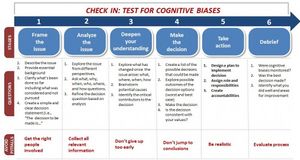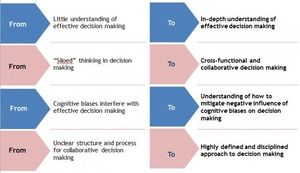Making Good Decisions
Is there anything more important to the success of a company than decision making? And is there any other process that occurs so often in a company that is accomplished so haphazardly?
The decisions that are made, from the boardroom and the corner office on down, dictate the direction that the company goes. Yet, decision making may be the only area of a company that doesn’t have a clear structure or process for maximizing quality. Think about it. Sales, marketing, finance, and research and development all have formal procedures in place to ensure that their outputs are both effective and efficient. There is, however, rarely such processes in place to ensure uniformity in the quality of a company’s decision making. And this absence can lead to some horrendous and potentially catastrophic decisions.
In my consulting work in the corporate world, I have found that business people have considerable confidence in their decision-making capabilities. I have also found that their confidence is often unjustified and sometimes based more in fantasy than reality. Research has also found that decision making is rife with cognitive biases that make objective and rational decisions incredibly difficult. Yet, little attention and time is devoted to creating a structure and process that will help develop that which facilitates good decision making and mitigates those factors that lead to poor decision making.
Precision Decision Model
Like any system, decision making is most effective when it is structured and organized. A decision-making system provides companies with a consistent process that can be adhered to and, after decisions have been made, evaluated and adjusted for the quality of their outputs.
Through my work in the business world, I have developed what I call the Precision Decision model of decision making (see image below).
precision decision
The Precision Decision model provides companies with a framework for quality decisions while allowing for flexibility in its implementation. My Precision Decision model is comprised of six stages that progressively guide you through the decision making process. Within the six stages are a series of specific questions and a key recommendation to avoid common pitfalls at the different points in the decision-making process.
Stage 1: Frame the Issue
This stage involves understanding with absolute clarity what the issue is and what type of decision is going to be made. Essential questions to ask include:
- What is the issue we are presented with?
- What is some essential background to the issue?
- What has been done so far including what has been considered and not pursued?
- What is a simple and clear statement that best describes the current decision (i.e., “The decision to be made is…”)?
The best decisions most often come from a collaboration between people with the ideal combination of knowledge, skill sets, perspectives, and experience. A common pitfall in this initial stage of decision making is not getting the right people involved. You can avoid this trap by identifying the areas of expertise that need to be included and carefully selecting a group of people who can provide a broad and deep perspective on the presenting issue.
Stage 2: Analyze the Issue
Once the issue has been clearly articulated and a decision statement has been created, it’s now time to do an extensive analysis of the issue and really delve into its many facets. Key areas to examine include:
- Explore the issue from different perspectives (e.g., using the diverse expertise of your decision-making team).
- Ask what, why, when, who, where, and how questions so the issue is fully revealed.
- Refine the decision statement based on this analysis.
At this stage, one of the most common pitfalls is to assume that you have your arms fully wrapped around the issue and are ready to make the decision. The best way to mitigate this pitfall is to ensure that you are collecting all of the relevant information that will contribute to a quality decision. This can be accomplished by asking the decision team members to leverage their knowledge and experience to bring forward any information that they deem germane, however esoteric it may seem.
Stage 3: Deepen Your Understanding
When your team feels that it has done a thorough analysis of the issue at hand and has a firm grasp of the decision that needs to be made, it’s ready to do a “deep dive” and plumb the depths of the decision. Important issues to consider include:
- What hat has changed since the issue arose: what, where, when, how.
- Brainstorm potential causes of the issue.
- Identify the critical contributors to the decision.
A frequent pitfall in this stage is to give up too early when you think that you have a real understanding of the issue. My recommendation is to allow the issue and the potential decision germinate in the relevant stakeholders.
Stage 4: Make the Decision
At some point, of course, a decision must be made. Here, where the rubber meets the road, is when you must take your broad and deep understanding of the issue and begin to identify possible decisions. Essential areas to consider include:
- Create a list of possible decisions that could be made.
- Explore possible outcomes of the decision options (worst and best cases).
- Make the decision.
- Ask yourself: Is the decision consistent with your values?
Jumping to conclusions is the most likely pitfall in this stage. As you filter through possible decisions, each can look very attractive and may cause you to choose one prematurely. It is best to commit to a thorough consideration of each decision option before you return to the one that you think is best.
Stage 5: Take Action
This stage is the scariest because you must “put your money where your mouth is.” It is also the point at which implementation of the idea becomes as important as the decision itself. As you likely know from experience, the best decisions can fail if they are not put into action effectively. As such, the following four steps will help ensure that the implementation maximizes the likelihood that the decision was, in fact, a good one.
- Design a plan to implement decision.
- Assign role and responsibilities.
- Establish a timetable.
- Create accountabilities.
A common pitfall in this stage is to be unrealistic in your expectations of the outcome of the decision. As with most things in business and life, decisions take time to take root and blossom. I suggest that you be patient and allow the decision to slowly reveal its worth.
Stage 6: Debrief
This stage is often one that is overlooked by companies because they are just too busy pursuing the future to take the time to reflect back on the past. This “forensic analysis” provides an evaluation of both the process and outcome of the decision making. Key questions to ask include:
- Were cognitive biases monitored?
- Was the best decision made?
- What you did well and areas for improvement?
Not surprisingly, the greatest pitfall is to not evaluate the decision. The fundamental lessons from the debrief are to identify what worked in the decision-making process (and repeat it) and identify what didn’t work (and jettison it). The result is that, with time and consistent adherence to the Precision Decision model, your company fine tunes and customizes the decision-making process until you have developed a system that works effectively with your unique culture and dynamics.
Cognitive Biases
As I noted in a previous article, cognitive biases are bad for business. Yet, they are also ever present in the business world. An essential part of the Precision Decision model involves constantly checking in at each stage of the process to ensure that cognitive biases have a negligible effect on the decisions that are made.
Conclusion
The ultimate outcome is a series of from-to shifts in decision making (see image below) that reduces the number of poor decisions and dramatically increases the number of sound decisions. And this conclusion can only mean good things for the future of your company.
Related Best Practices
Resources
- "Cognitive Biases and “Doing Your Own Research, Part 1 – Decision Making, Belief and Behavioral Biases", by Christopher_NW February 25, 2013, Mostly Science.
- Decision Making at Wikipedia
- "How Good is Your Decision-Making?" at Mind Tools. An online test to measure your decision making skills.
Author
The author of this page is Dr. Jim Taylor
Dr. Jim Taylor is an internationally recognized authority on the psychology of performance in business, sport, and parenting.
Dr. Taylor has been a consultant to and has provided individual and group training to businesses, sports teams and medical facilities.executives and businesses throughout the world.
Dr. Taylor received his Bachelor’s degree from Middlebury College and earned his Master’s degree and Ph.D. in Psychology from the University of Colorado. He is a former Associate Professor in the School of Psychology at Nova University in Ft. Lauderdale and a former clinical associate professor in the Sport & Performance Psychology graduate program at the University of Denver. He is currently an adjunct faculty at the University of San Francisco and the Wright Institute in Berkeley.
Dr. Taylor’s professional areas of interest include corporate performance, sport psychology, coaches education, child development and parenting, injury rehabilitation, popular culture, public education reform, and the psychology of technology.
He has published more than 700 articles in scholarly and popular publications, and has given more than 800 workshops and presentations throughout North and South America, Europe, and the Middle East. Dr. Taylor is the author of 14 books.
Dr. Taylor blogs on business, technology, sports, parenting, education, politics, and popular culture on this web site, as well as on huffingtonpost.com, psychologytoday.com, seattlepi.com, and the Hearst Interactive Media Connecticut Group web sites. His posts are aggregated by dozens of web sites worldwide and have been read by millions of people. A full biography is found on Dr. Taylor's website.

